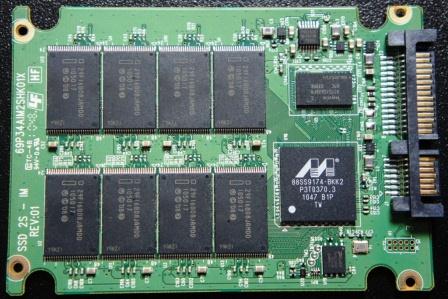INTERNAL COMPOSITION
We almost feel like there should be some type of warning with respect to the pictures below of the PCB, a warning that might assure the reader of photograph authenticity. The simple truth is that we were left speachless on first observation of the internal SSD components.
The Intel 510 Series 250GB SSD is controlled by the Marvell 88S9174 SATA 3 controller and not by an Intel propietary controller as all would have expected. This controller has received the head nod of companies such as Micron/Crucial, Corsair, Patriot, SuperTalent and many others who have already integrated it into their newly released and soon to be released, SSD lineups.
Eight chips of Intel 34nm NAND flash memory line both sides of the PCB, each being 16GB in size for a total size composition of 256GB. There is also a Hynix DDR3 128MB cache situated on the board as well. The SSD is advertised as a 250 GB SSD as this is the available RAW capacity after firmware requirements and the final formatted capacity reduces it to 232 GB of storage available to the user.
TEST BENCH AND PROTOCOL
 This is The SSD Review Test Bench and a quick click on the photo will bring it up full size for closer inspection.
This is The SSD Review Test Bench and a quick click on the photo will bring it up full size for closer inspection.
TEST PROTOCOL
- Our main goal in testing is to ensure that all test results are as accurate as they can be and no anomalies slip through. We conduct all tests three times and, if necessary, we may conduct specific tests in Windows 7 ‘safe mode’ to ensure the OS has little to no influence on the end result.
- We prefer to use as many benchmark programs as possible to assist with confirmation of results and provide the reader with the actual tests as received to avoid any confusion when unexpected test benchmarks are received.
BENCH CONFIGURATION
MOTHERBOARD: Gigabyte P67A-UD7 ATX LGA 1155 Intel SATA 6Gb/s USB 3.0
CPU: Intel Core i7-2600K Sandy Bridge 3.4GHz (3.8GHz Turbo Boost) 4 x 256KB L2 Cache 8MB L3 Cache LGA 1155 95W Quad-Core Desktop Processor
RAM: Corsair Vengeance 8GB DDR3 1600 SDRAM
GPU: MSI N560GTX-Ti Twin Frozr II OC Edition 1024MB GDDR5 PCI Express 2.0
POWER: Corsair Professional Series AX850 850W ATX12V v2.31 / EPS12V v2.92 80 PLUS GOLD Certified Modular Active PFC Power Supply
CHASSIS: Fractal-Design Define XL ATX Mid Tower Silent Computer Case
CPU COOLER: Corsair H50 High Performance Water CPU Cooler
NETWORK: DiLink Powerline AV Network With D-Link DIR 655 Wifi N Router
DVD: Sony Black 24X DVD+R 8X DVD+RW 8X DVD+R DL 24X DVD-R 6X DVD-RW 12X DVD-RAM 16X DVD-ROM 48X CD-R 32X CD-RW 48X CD-ROM 2MB Cache SATA 24X DVD Writer
STORAGE: 3 x Icy Dock 4×1 SSD Racks for 5.25″ Device Bay
Software used for testing by The SSD Review consists of Crystal Disk Mark, HDTune Pro, ATTO Benchmark, HDTach, AS SSD, Windows Experience Index Rating along with FutureMark PCMark Vantage.
The first six do a great job of showing us the numbers that we want to see, or dont want to see in some cases, while PCMark Vantage x64 is an excellent program which recreates tests that mimic the average users activity, all the while providing a medium to measure each.
PG 1 – INTRODUCTION
PG2 – INTERIOR DESIGN AND BENCHMARK PROTOCOL
PG3 – INITIAL TESTING
PG4 – BENCHMARK TESTING
 The SSD Review The Worlds Dedicated SSD Education and Review Resource |
The SSD Review The Worlds Dedicated SSD Education and Review Resource | 
